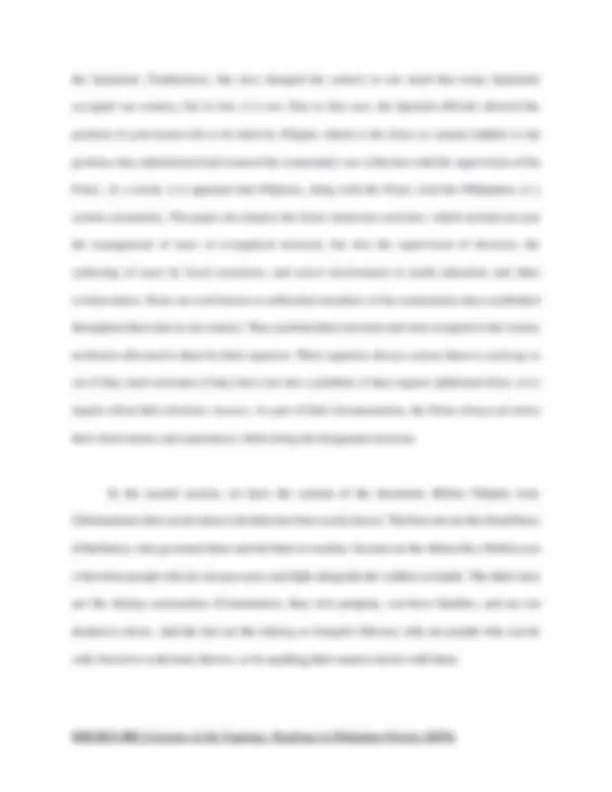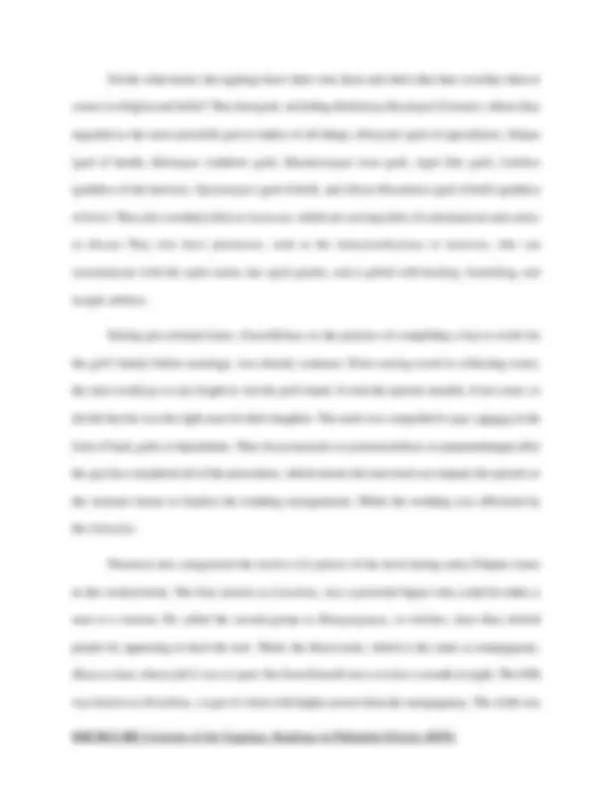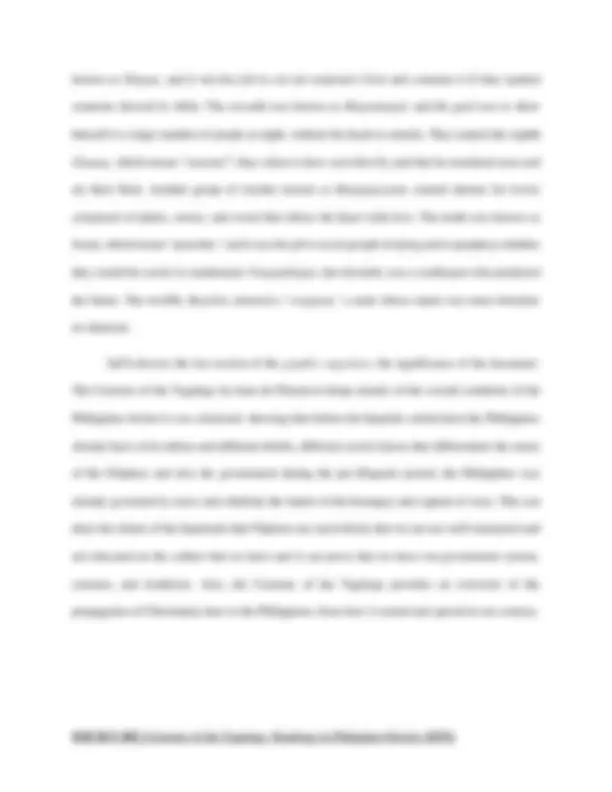





Study with the several resources on Docsity

Earn points by helping other students or get them with a premium plan


Prepare for your exams
Study with the several resources on Docsity

Earn points to download
Earn points by helping other students or get them with a premium plan
Community
Ask the community for help and clear up your study doubts
Discover the best universities in your country according to Docsity users
Free resources
Download our free guides on studying techniques, anxiety management strategies, and thesis advice from Docsity tutors
This is a short analysis of the customs of the Tagalogs.
Typology: Study Guides, Projects, Research
1 / 7

This page cannot be seen from the preview
Don't miss anything!




Introduction In today’s generation, history plays an important role in our community and society. This is one of the essential pieces of knowledge that we must learn and attained as an individual of the country who has their past and history that until the present has a significance; not only in our societies, cultures, and government but also the identity of the people of the certain country. The rich history of the country helps us to draw and paint a detailed picture of where we stand these days. Several written histories may contribute to every Filipino and one of these is the “Customs of the Tagalog” that was written by Juan de Plasencia in 1589, a Spanish friar of the Franciscan order. This written document was intentionally made to describe the political, social, economic, and cultural traditions and practices of the Filipinos before they were Christianized. Also, this document provides an exoticize portrayal of the Filipinos, clearly fed by politics and propaganda and they want to show how great their contribution was to our development. This analysis of ‘Customs of Tagalog’ will focus on the historical context, the document’s content, and the significance of this written document.
Discussion We used the concept map diagram to illustrate the concept and ideas of the Customs of the Tagalogs. In our analysis of the written document of Juan de Plasencia, we define the historical context, content, and significance of the document. The first section of the graphic organizer referred to the historical context of the document which is the Customs of the Tagalog. During the Spanish colonization in the Philippines, it is obvious that there are difficulties in running the political system under the Spaniards because of the limited numbers of them, were in fact, Filipinos are having numerous numbers than the colonizers. So, some historians believe that the Filipinos simply accepted their fate at the hands of Social Classes of Filipino Religious and Beliefs of Filipino Marriage Customs Classification of Witches Details of overall condition of Philippines before it was colonized. Refuted Spaniards claim that the Philippines is uncivilized. Overview of propagation of Christianity. Limited number of Spaniards. Spanish officials allow Filipino to hold the position gobernadorcillo. Friars assigned in administrative duties. Friars assigned in mission territories.
On the other hand, the tagalogs have their own ideas and idols that they worship when it comes to religion and belief. They had gods, including Bathalang Maykapal (Creator), whom they regarded as the most powerful god or maker of all things, Idinayale (god of agriculture), Sidapa (god of death), Balangaw (rainbow god), Mandarangan (war god), Agni (fire god), Lalahon (goddess of the harvest), Siginarugan (god of hell), and Diyan Masalanta (god of hell) (goddess of love). They also worship Likha or Larawan , which are carving idols of a dead person and anitos or diwata. They also have priestesses, such as the babaylan/baylana or katalona , who can communicate with the spirit realm, has spirit guides, and is gifted with healing, foretelling, and insight abilities. During pre-colonial times , Paninilbihan , or the practice of compelling a boy to work for the girl's family before marriage, was already common. From sawing wood to collecting water, the man would go to any length to win his girl's hand. It took the parents months, if not years, to decide that he was the right man for their daughter. The male was compelled to pay a dowry in the form of land, gold, or dependents. They do pamamalae or pamamanhikan , or pamumulungan after the guy has completed all of the procedures, which means the man must accompany his parents to the woman's house to finalize the wedding arrangements. While the wedding was officiated by the babaylan. Plasencia also categorized the twelve (12) priests of the devil during early Filipino times in this written book. The first, known as Catolona , was a powerful figure who could be either a man or a woman. He called the second group as Mangangauay , or witches, since they tricked people by appearing to heal the sick. Third, the Manyisalat , which is the same as mangagauay. Mancocolam , whose job it was to spew fire from himself once or twice a month at night. The fifth was known as Hocloban , a type of witch with higher power than the mangagauay. The sixth was
known as Silagan , and it was his job to cut out someone's liver and consume it if they spotted someone dressed in white. The seventh was known as Magtatangal , and his goal was to show himself to a large number of people at night, without his head or entrails. They named the eighth Osuang , which means "sorcerer”; they claim to have seen him fly and that he murdered men and ate their flesh. Another group of witches known as Mangagayoma created charms for lovers composed of plants, stones, and wood that infuse the heart with love. The tenth was known as Sonat, which means "preacher," and it was his job to assist people in dying and to prophesy whether they would be saved or condemned. Pangatahojan , the eleventh, was a soothsayer who predicted the future. The twelfth, Bayohin , denoted a " cotquean ," a male whose nature was more feminine in character. Let’s discuss the last section of the graphic organizer , the significance of the document. The Customs of the Tagalogs by Juan de Plasencia brings details of the overall condition of the Philippines before it was colonized, showing that before the Spanish colonization the Philippines already had a rich culture and different beliefs, different social classes that differentiate the status of the Filipinos and also the government during the pre-Hispanic period, the Philippines was already governed by datus and chieftain the leader of the barangay and captain of wars. This can deny the claims of the Spaniards that Filipinos are uncivilized, that we are not well-mannered and not educated on the culture that we have and it can prove that we have our government system, customs, and traditions. Also, the Customs of the Tagalogs provides an overview of the propagation of Christianity here in the Philippines, from how it started and spread in our country.
Members of the group: Ana Enrica Yuson Contribution: Analysis/Critique Rina Apple Yamato Contribution: Analysis/Proofread Arnie Jean Yanga Contribution: Analysis/Proofread Kenjie Victoria Contribution: Analysis/Editor